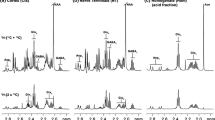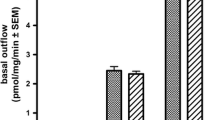Summary
Measurement of glucose utilization after 20 minutes of seizure activity induced by the systemic administration of convulsants in paralyzed, ventilated rats demonstrates that the initial metabolic activation during kainic acid seizures is confined to the hippocampus. L-allylglycine-induced generalized seizures result in a global metabolic activation, whereas bicuculline seizures in fasted rats have little effect on brain glucose utilization after 20 minutes of seizure activity.
Other metabolic changes associated with kainic acid seizures also predominate in the hippocampus, were decreases in the levels of aspartate, glutamate, taurine and glutamine, and an increase in the level of GABA are observed after 20 minutes of seizure activity. L-allylglycine seizures are associated with generalized decreases in regional GABA levels, and increases in regional glutamine levels. Bicuculline-induced changes include increases in hippocampal GABA and taurine levels, and increases in cerebellar glutamine and taurine levels. These changes can be tentatively explained in terms of known biochemical and neurophysiological mechanisms of these convulsants.
Similar content being viewed by others
References
Baba, A., Okumura, S., Mizuo, H., Iwata, H.: Inhibition by Diazepam andγ-aminobutyric acid of depolarization-induced release of [14C] cysteine sulfinate and [3H] glutamate in rat hippocampus slices. J. Neurochem.40, 280–284 (1983).
Ben-Ari, Y., Tremblay, E., Riche, D., Ghilini, D., Naquet, R.: Electrographic, clinical and pathological alterations following systemic administration of kainic acid, bicuculline or pentetrazole: Metabolic mapping using the deoxyglucose method with special reference to the pathology of epilepsy. Neurosci.6, 1361–1391 (1981).
Borgström, L., Chapman, A. G., Siesjö, B. K.: Glucose consumption in the cerebral cortex during bicuculline-induced status epilepticus. J. Neurochem.27, 971–973 (1976).
Blennow, G., Folbergrová, J., Nilsson, B., Siesjö, B. K.: Effects of bicuculline-induced seizures on cerebral metabolism and circulation in rats rendered hypoglycemic by starvation. Ann. Neurol.5, 139–151 (1979).
Chapman, A. G.: Cerebral energy metabolism and seizures. In: Recent Advances in Epilepsy, Vol. 2 (Pedly, T. A., Meldrum, B. S., eds.), pp. 19–63. New York: Churchill Livingstone. 1985.
Chapman, A. G., Meldrum, B. S., Siesjö, B. K.: Cerebral metabolic changes during prolonged epileptic seizures in rats. J. Neurochem.28, 1025–1035 (1977).
Chapman, A. G., Evans, M. C.: Cortical GABA turnover during bicuculline seizures in rats. J. Neurochem.41, 886–889 (1983).
Chapman, A. G., Westerberg, E., Premachandra, M., Meldrum, B. S.: Changes in regional neurotransmitter amino acid levels in rat brain during seizures induced by L-allylglycine, bicuculline, and kainic acid. J. Neurochem.43, 62–70 (1984).
Collins, G. G. S.: The effects of chlordiazepoxide on synaptic transmission and amino acid neurotransmitter release in slices of rat olfactory cortex. Brain Res.224, 389–404 (1981).
Collins, R. C., Lothman, E. W., Olney, J. W.: Status epilepticus in the limbic system: Biochemical and pathological changes. In: Status Epilepticus. Mechanisms of Brain Damage and Treatment (Delgado-Escueta, A. V., Wasterlain, C. G., Treiman, D. M., Porter, R. J., eds.), pp. 277–288. New York: Raven Press. 1983.
Curtis, D. R., Duggan, A. W., Felix, D., Johnston, G. A. R.: GABA, bicuculline and central inhibition. Nature226, 1222–1224 (1970).
Curtis, D. R., Johnston, G. A. R.: Amino acid transmitters in the mammalian central nervous system. Ergeb. Physiol. Biol. Chem. Exp. Pharmacol.69, 97–188 (1974).
Dodd, P. R., Bradford, H. F., Abdul-Ghani, A. S., Cox, D. W. G.: Release of amino acids from chronic epileptic and sub epileptic fociin vivo. Brain Res.193, 505–517 (1980).
Evans, M. C., Griffiths, T., Meldrum, B. S.: Early changes in the rat hippocampus following seizures induced by bicuculline or L-allylglycine: A light and electron microscope study. Neuropath. Appl. Neurobiol.9, 39–52 (1983).
Evans, M. C., Meldrum, B. S.: Regional brain glucose metabolism in chemically-induced seizures in the rat. Brain Res.297, 235–245 (1984).
Evans, M. C., Griffiths, T., Meldrum, B. S.: Kainic acid seizures and the reversibility of calcium loading in vulnerable neurons in the hippocampus. Neuropath. Appl. Neurobiol.10, 285–302 (1984).
Ferkany, J. W., Coyle, J. T.: Kainic acid selectively stimulates the release of endogenous excitatory acidic amino acids. J. Pharmacol. Exp. Ther.225, 399–406 (1983).
Fonnum, F., Walaas, I.: The effect of intrahippocampal kainic acid injection and surgical lesions on neurotransmitters in hippocampus and septum. J. Neurochem.31, 1173–1181 (1978).
Frederickson, R. C. S., Neuss, M., Morzerati, S. L., McBride, W. J.: The comparison of the inhibitory effects of taurine and GABA on identified purkinje cells and other neurons in the cerebellar cortex of the rat. Brain Res.145, 117–126 (1978).
Giorgi, O., Meek, J. L.:γ-aminobutyric acid turnover in rat striatum: Effects of glutamate and kainic acid. J. Neurochem.42, 215–220 (1984).
Griffiths, T., Evans, M. C., Meldrum, B. S.: Temporal lobe epilepsy, excitotoxins and the mechanism of selective neuronal loss. In: Excitotoxins. Wenner-Gren International Symposium Series. Vol. 39 (Fuxe, K., Schwarz, R., Roberts, P. J., eds.), pp. 331–342. London: Macmillan. 1983 a.
Griffiths, T., Evans, M. C., Meldrum, B. S.: Intracellular calcium accumulation in rat hippocampus during seizures induced by bicuculline or L-allylglycine. Neurosci.10, 385–395 (1983 b).
Horton, R. W., Chapman, A. G., Meldrum, B. S.: Regional changes in cerebral GABA concentration and convulsions produced by D- and L-allylglycine. J. Neurochem.30, 1501–1504 (1978).
Horton, R. W., Meldrum, B. S., Pedley, T. A., McWilliam, J. R.: Regional cerebral blood flow in the rat during prolonged seizure activity. Brain Res.192, 399–412 (1980).
Ingvar, M., Siesjö, B. K.: Local blood flow and glucose consumption in the brain during sustained bicuculline-induced seizures. Acta Neurol. Scand.68, 129–144 (1983).
Ingvar, M., Söderfeldt, B., Folbergrová, J., Kalimo, H., Olsson, Y., Siesjö, B. K.: Metabolic, circulatory, and structural alterations in the rat brain induced by sustained pentylenetetrazol seizures. Epilepsia25, 191–204 (1984).
Kerwin, R. W., Meldrum, B. S.: Effect on cerebral D-[3H] aspartate release of 3-mercaptopropionic acid and methyl-6, 7-dimethoxy-4-ethyl-β-carboxylate. Eur. J. Pharmacol.89, 265–269 (1983).
Lehmann, A., Isacsson, H. M., Hamberger, A.: Effects ofin vivo administration of kainic acid on the extracellular amino acid pool in the rabbit hippocampus. J. Neurochem.40, 1314–1320 (1983).
Meldrum, B. S.: Epilepsy andγ-aminobutyric acid-mediated inhibition. Int. Rev. Neurobiol.17, 1–36 (1975).
Meldrum, B. S.: Metabolic factors during prolonged seizures and their relation to nerve cell death. In: Status Epilepticus. Mechanism of Brain Damage and Treatment (Delgado-Escueta, A. V., Wasterlain, C. G., Treiman, D. M., Porter, R. J., eds.), pp. 261–275. New York: Raven Press. 1983.
Meldrum, B.: Amino acid neurotransmitters and new approaches to anticonvulsant drug action. Epilepsia25, 140–149 (1984).
Meldrum, B. S., Nilsson, B.: Cerebral blood flow and metabolic rate early and late in prolonged epileptic seizures induced in rats by bicuculline. Brain Res.99, 523–542 (1976).
Meldrum, B. S., Chapman, A. G.: Excitatory amino acids and anticonvulsant drug action. In: Glutamine, Glutamate, and GABA in the Central Nervous System, pp. 625–641. New York: Alan R. Liss. 1983.
Nicklas, W. J., Krespan, B., Berl, S.: Effect of kainate on ATP levels and glutamate metabolism in cerebellar slices. Eur. J. Pharmacol.62, 209–213 (1980).
Peričić, D., Eng, N., Walters, J. R.: Post-mortem and aminooxy-acetic acid-induced accumulation of GABA: Effect of gammabutyrollactone and picrotoxin. J. Neurochem.30, 767–773 (1978).
Pinard, E., Ben-Ari, Y., Tremblay, E., Seylaz, J.: Is intratissue hypoxia responsible for hippocampal lesions during seizures induced by kainic acid? In: Current Problems in Epilepsy: I. Cerebral Blood Flow, Metabolism and Epilepsy (Baldy-Moulinier, M., Ingvar, D. H., Meldrum, B. S., eds.), pp. 252–257. London: J. Libbey. 1984.
Potashner, S. J., Gerard, D.: Kainate-enhanced release of D-[3H] aspartate from cerebral cortex and striatum: reversal by baclofen and pentobarbital. J. Neurochem.40, 1548–1557 (1983).
Schmid, R., Hong, J. S., Meek, J., Costa, E.: The effect of kainic acid on the hippocampal content of putative transmitter amino acids. Brain Res.200, 355–362 (1980).
Schwarcz, R., Zaczek, R., Coyle, J. T.: Microinjection of kainic acid into the rat hippocampus. Eur. J. Pharmacol.50, 209–220 (1978).
Skerritt, J. H., Johnston, G. A. R.: Enhancement of excitant amino acid release from rat brain slices by the convulsant 3-mercaptopropionic acid. Brain Res.258, 165–169 (1983).
Skerritt, J. H., Johnston, G. A. R.: Modulation of excitant amino acid release by convulsant and anticonvulsant drugs. In: Neurotransmitters, Seizures and Epilepsy (Fariello, R. G., Morselli, P. L., Lloyd, K. G., Quesney, L. P., Engel, J. Jr., eds.), pp. 215–226. New York: Raven Press. 1984.
Sokoloff, L., Reivich, M., Kennedy, C., Des Rosiers, R. H., Patlak, C. S., Pettigrew, K. D., Sakurada, O., Shinohara, M.: The [14C] deoxyglucose method for the measurement of local cerebral glucose utilization: theory, procedure and normal values in the conscious and anaesthetized albino rat. J. Neurochem.28, 897–916 (1977).
Szerb, J. C.: Effect of nipecotic acid, aγ-aminobutyric acid transport inhibitor, on the turnover and release ofγ-aminobutyric acid in rat cortical slices. J. Neurochem.39, 850–858 (1982).
Author information
Authors and Affiliations
Rights and permissions
About this article
Cite this article
Chapman, A.G. Regional changes in transmitter amino acids during focal and generalized seizures in rats. J. Neural Transmission 63, 95–107 (1985). https://doi.org/10.1007/BF01252610
Issue Date:
DOI: https://doi.org/10.1007/BF01252610




